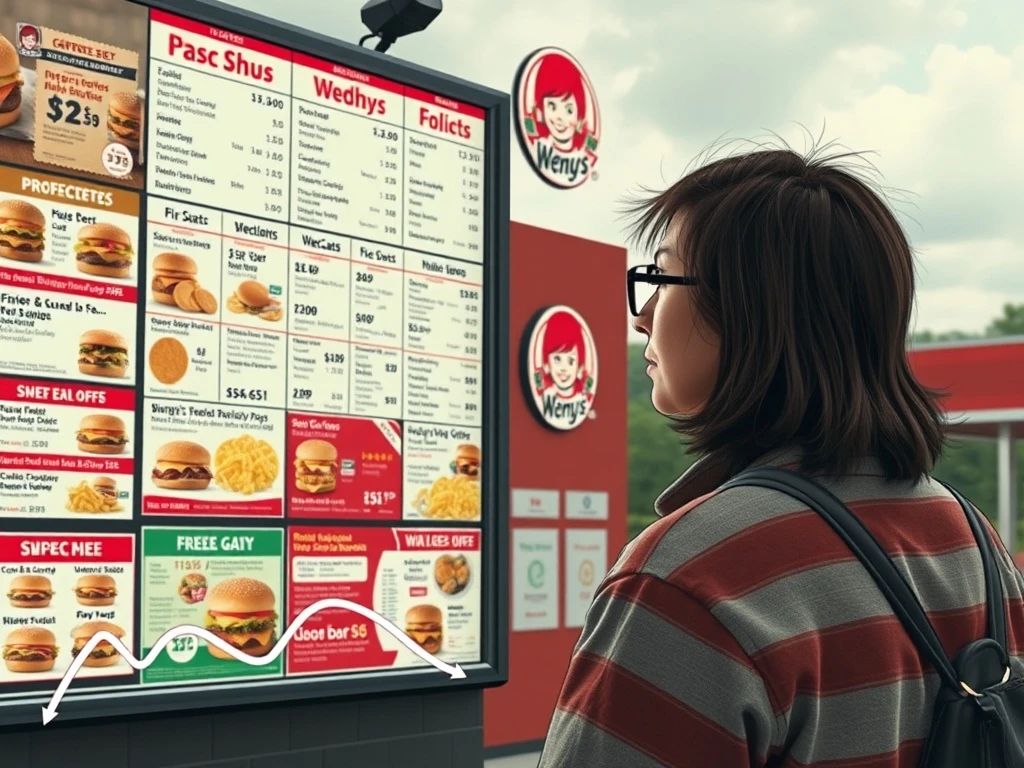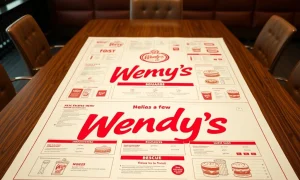The fast-food landscape constantly shifts. Recently, Wendy’s, a prominent player, reported an unexpected dip in its U.S. sales. This decline surprised many market watchers. Interestingly, the company attributed this weakness not to lack of demand, but to an excess of its own marketing efforts. Specifically, Wendy’s sales faced challenges because customers felt overwhelmed by too many promotions. This unique situation highlights the delicate balance in consumer engagement strategies. It offers a crucial lesson for businesses aiming to connect with their audience.
Wendy’s Sales Decline: A Deeper Look
Initially, investors might expect sales issues to stem from poor product quality or fierce competition. However, Wendy’s presented a different narrative. Their executives explained that an abundance of diverse promotional offers created significant confusion among patrons. Customers struggled to discern the best deals. This included navigating complex pricing structures and differentiating between various bundled offers. Consequently, this complexity led to decision paralysis, impacting transaction volume across many U.S. locations. For instance, a customer might hesitate at the drive-thru, unsure which combination of deals offered the most value for their money. Furthermore, the sheer volume of promotions diluted the perceived value of individual offers. When every visit promises a new deal, no single offer feels truly special. Ultimately, this saturation directly contributed to the softer Wendy’s sales figures reported for the recent quarter. This situation highlights a critical marketing misstep.
The Paradox of Choice in Fast Food
The concept of “too much choice” is well-documented in consumer psychology. Psychologist Barry Schwartz popularized this idea. He argued that while some choice is good, excessive options can lead to anxiety and dissatisfaction. In the fast-food industry, quick decisions are paramount. Customers often visit for convenience and speed. They expect a straightforward ordering process. When faced with an array of overlapping discounts, special bundles, and limited-time offers, the decision-making process significantly slows. For instance, a customer might spend extra time comparing options on a digital kiosk or a physical menu board. This delay can frustrate patrons, especially during peak lunch or dinner hours. Moreover, it can lead to customers choosing simpler, non-promotional items. Sometimes, they might even abandon their purchase altogether due to frustration. Therefore, while promotions aim to boost traffic and perceived value, an excessive number can inadvertently deter it. This applies equally to in-store and online ordering experiences. The goal should be to guide, not overwhelm, the customer.
Understanding the Impact on Wendy’s Operations
The confusion over promotions did more than just slow down order lines. It also significantly affected the average check size. When customers are unsure which deal offers the best value, they might default to a cheaper, simpler option. Alternatively, they might opt for a competitor with a clearer pricing structure and less mental effort required. This directly impacts revenue per customer. Furthermore, managing numerous promotions adds considerable operational complexity for staff members. Employees must stay updated on all active deals. They also need to understand the intricate terms and conditions of each offer. They must also explain these offers patiently to confused customers. This can lead to longer service times and potential errors at the point of sale. These issues further degrade the overall customer experience. Consequently, these operational inefficiencies collectively weighed down Wendy’s sales performance across the U.S. market. The company faced a dual challenge: declining customer satisfaction and reduced profitability per transaction. This internal strain compounded the external marketing problem.
Lessons from Competitors and the Market
Other fast-food chains constantly employ promotional strategies. However, successful ones typically maintain clarity and consistency. McDonald’s, for example, frequently rotates a few distinct value menus like their “2 for $X” deals. They also use the popular “McRib” or “Shamrock Shake” as clear, seasonal limited-time offers. Burger King also uses targeted promotions, often highlighting specific new items or combo meals. Their approach frequently involves simpler, easily understandable offers presented in a straightforward manner. This allows customers to quickly grasp the value proposition without extensive thought. In contrast, Wendy’s recent strategy appears to have overcomplicated its messaging. The competitive landscape demands not just attractive deals, but also clear and concise communication. Therefore, Wendy’s must re-evaluate its promotional framework urgently. The primary goal should be to simplify choices without sacrificing promotional appeal or perceived value. This is a crucial step for future growth and regaining customer trust. Learning from industry leaders is essential here.
Rebalancing Promotional Strategy for Stronger Wendy’s Sales
Moving forward, Wendy’s faces the immediate task of refining its marketing approach. This involves a strategic reduction in the sheer number of concurrent promotions. They should also focus on making existing offers more distinct and easily understandable. Clear communication is paramount across all customer touchpoints, from menu boards to digital apps. Perhaps a tiered approach could be beneficial. For instance, they could feature a limited number of “anchor” promotions that are consistently available and easily recognizable. These might include a permanent value menu or core bundle deals. Additionally, they might introduce a few short-term, highly targeted deals to create excitement without causing widespread confusion. This strategy would prevent customer overload. It would also allow each promotion to stand out individually. Furthermore, leveraging digital channels more effectively could help. Personalized offers delivered via the app could reduce clutter for general customers. Ultimately, simplifying the promotional landscape could reinvigorate Wendy’s sales and significantly improve customer satisfaction. The company’s future success hinges on this critical adjustment and a renewed focus on clarity in its marketing messages. This strategic pivot will be closely watched by the industry.
The Broader Implications for Business Strategy
Wendy’s experience offers a significant lesson for businesses beyond the fast-food sector. In today’s highly competitive markets, companies constantly strive to attract and retain customers. Promotions are a powerful tool in this endeavor. However, the incident with Wendy’s sales underscores a vital principle: the customer experience must remain seamless. Overloading consumers with options, even seemingly beneficial ones, can backfire. It can erode trust and create frustration. Therefore, businesses must prioritize clarity and simplicity in their offerings. This applies to product lines, service packages, and marketing campaigns alike. A well-executed strategy focuses on guiding the customer toward a clear value proposition. It avoids unnecessary complexity. Ultimately, sustainable growth stems from a deep understanding of consumer behavior. It requires a balanced approach to marketing that prioritizes ease of understanding over sheer volume of offers. Companies must consider the long-term impact on brand perception and customer loyalty. This incident serves as a stark reminder.
Conclusion: A Cautionary Tale for Marketers
The recent dip in Wendy’s U.S. sales offers a valuable lesson for marketers and business strategists alike. While promotions are vital for driving traffic and engagement, their overuse can undeniably backfire. Customer confusion, rather than economic weakness or product issues, emerged as the primary culprit behind the softer performance. This unique situation underscores the critical importance of strategic clarity in all marketing efforts. Companies must carefully consider the cognitive load placed on consumers. As Wendy’s navigates this challenge, its ability to simplify its message will be paramount for regaining momentum. This experience serves as a compelling cautionary tale for all businesses. It highlights that effective marketing is about quality, precision, and clarity, not merely about the quantity of offers. Prioritizing the customer’s ease of understanding is crucial for sustained success.
Frequently Asked Questions (FAQs)
- What caused Wendy’s U.S. sales to be weak?
Wendy’s reported that an excessive number of promotions led to customer confusion, which in turn impacted transaction volume and overall U.S. sales. - What is “decision paralysis” in this context?
Decision paralysis occurs when customers are presented with too many options or complex choices. This can make them hesitant to decide, slow down their ordering, or even lead them to abandon a purchase. - How do other fast-food chains manage promotions successfully?
Successful fast-food chains often employ fewer, clearer promotions. They might rotate distinct value menus or offer easily understandable seasonal deals, prioritizing simplicity and clear communication. - What steps might Wendy’s take to improve its sales?
Wendy’s is expected to refine its marketing strategy by reducing the number of concurrent promotions, making existing offers more distinct, and improving communication to simplify customer choices. - What broader lesson does this offer for businesses?
This situation teaches businesses that while promotions are important, an overload of options can backfire. Prioritizing clarity, simplicity, and a seamless customer experience is crucial for sustainable growth and brand loyalty. - How does promotional confusion impact staff and operations?
Too many promotions can create operational complexity for staff. Employees must understand and explain intricate deals, leading to longer service times, potential errors, and a degraded customer experience.
























